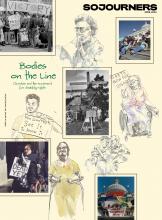IN A 2001 lecture titled “Devotional Cinema,” filmmaker and film editor Nathaniel Dorsky broadly described devotional practice as “the interruption that allows us to experience what is hidden and to accept with our hearts our given situation.” Dorsky connected this definition to the experience of watching a movie, claiming, “It is alive as a devotional form,” allowing viewers to uncover truths about themselves and the world by watching someone else’s story. A movie doesn’t have to be experimental art, a heavy drama, or a religious epic to be a devotional experience. Often, the most profound stories are about the subtle changes of the soul over time and the experiences and relationships that define a person. We relate to them because, like a devotional practice, they help us reflect on our own lives and consider how we live in relation to others.
Joachim Trier’s The Worst Person in the World is one such film, following its protagonist, Julie (Renate Reinsve), from her late 20s to her early 30s. Trier places Julie as the main character of her own story, narrated to us as she lives it, changing careers, falling in love, breaking up, experiencing loss, and becoming wiser and more comfortable with herself as a result.
Read the Full Article

